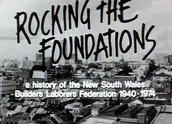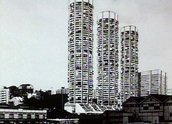


Rocking the Foundations (1985)
Synopsis
Rocking the Foundations covers the New South Wales Builders’ Labourers Federation (BLF) from 1940 until its demise in 1975. Set against the massive social and political upheavals of the 1960s and ’70s – the Vietnam War, Aboriginal land rights, women’s liberation and the environmental movement – the documentary depicts how the NSW BLF membership, by using their collective power, succeeded in preventing the massive destruction of many of Sydney’s historic areas, residential neighbourhoods, public parks and harbour shore. Told primarily through interviews with the members themselves, the film climaxes with the introduction of union bans on millions of dollars’ worth of high-rise development in the early-to-mid 1970s.
Curator’s notes
Rocking The Foundations is more than a film about a union. It’s a film about social change and how ordinary people can make that happen. It’s also an example of the independent documentary filmmaking that emerged with the social and political change of the 1970s and ’80s from people who felt that their stories, and the way they saw the world, were not represented by the mass media. Major social changes were documented by the people at the forefront – students, unionists, feminists, gays and lesbians and Aboriginal activists.
Shot in stunning black-and-white and told through interviews, historical footage and graphics, the film tells the story of how a union stood up to the NSW government and major real estate developers to stop Sydney turning into a high-rise jungle (see clip one).
Known as 'Green Bans’, the NSW BLF, having secured membership approval and the support of resident action groups, refused to demolish historical buildings and homes and banned any construction on open areas and parklands. Union members protested alongside inner-city residents in defiance of the developers, security teams, the police and the government. Using simple animation to show planned demolitions and developments the film shows a horrifying future for Sydney. The plans involved a proposal for 350 miles of freeway, demolition of historical areas – including The Rocks, Victoria St, Woolloomooloo – the eviction of 80,000 people and the turning of Centennial Park into a sports stadium. If the union and resident activists had not been successful in their battle to prevent hundreds of re-developments, Sydney would not be the beautiful city that it is today (see clip two).
The film’s historical footage shows the bitter fighting between demonstrators and activists squatting in houses marked for demolition. It is easy today to sympathise with their cause but at the time the BLF was seen mostly as a rabid union of thugs getting in the way of progress. The power of this documentary is that it shows how these unskilled workers organised themselves into a progressive force for change in the wider community (see clip three).
Rocking the Foundations was made in 1985 but the filmmaker, Pat Fiske, had already made another documentary, Woolloomooloo (1978), that recorded the struggle to save that area of inner-city Sydney from development. Around the same time another well-known documentary filmmaker, Tom Zubrycki, made Waterloo (1981) about the fight to save a neighbouring working-class area. Both these films, along with documentaries, news stories and other media coverage from the time, provide the historically significant raw material for Rocking The Foundations to tell its story. Without this archive the richness in the telling of this piece of powerful Australian history would have been lost.
As an American making a film about Australian history, Pat Fiske was aware that she had to make it from her own experience working inside the union. She makes this clear in her narration, describing the film as 'a history’ not 'the history’, personalising who was making the film and why (see clip one). This more personal perspective distinguished the documentary filmmakers in the 1970s and ’80s who departed from the traditional use of an unidentified authoritative male voice-over.
While working as a builders’ labourer, Pat Fiske attended the Blinky Bill Film Workshop run by the Sydney Filmmakers Co-operative which sparked her interest in telling the BLF story. The filmmakers’ co-ops in Melbourne and Sydney were set up to distribute independent films that communicated political ideas that weren’t being covered by the established media. The film took five years to make and Fiske had to 'beg, borrow and steal’ to do it because the budget was so small. Fiske has gone on to make many more documentaries but this is the film she feels 'most proud of’.
Rocking The Foundations was funded by the Australian Film Commission which was set up in the ’70s. This was a landmark for Australian film because it allowed filmmakers to make films outside of commercial or government-owned production companies and television. The Creative Development Branch of the AFC developed and funded many filmmakers, like Fiske, who have gone on to make a major contribution to the telling of Australian stories, theatrically and on television, both here and internationally.
Although made over 20 years ago, Rocking The Foundations remains an engaging history told by great characters and shot on locations around a changing urban landscape at a time of global upheaval. But mostly, it is the universal theme of people taking power into their own hands to defend their rights, that makes this film timeless.
Distributed by Ronin Films, Rocking the Foundations was theatrically released to critical acclaim at the Chauvel Cinema, Sydney, in 1986 where it had a four-week season. The film then toured nationally. Nominated for Best Documentary at the 1986 AFI Awards it won Best Screenplay and Best Editing. Screenings at the Edinburgh Film Festival and the United States Film Festival followed. It was broadcast in prime time on ABC television in 1987, again to good reviews.
- Overview
- Curator’s notes
- Video 3 clips
- Principal credits
- Find a copy
- Make a comment
- Map
- Add your review



